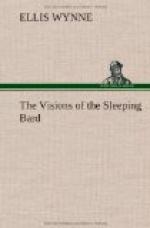It is said by his biographers that he was induced to abandon the pursuit of the law, to which he was educated, and to take holy orders, by Bishop Humphreys, who had recognised in his translation of the Holy Living marked ability and piety, and that he was ordained deacon and priest the same day by the Bishop, at Bangor, in 1701, and presented on the following day to the living of Llanfair-juxta-Harlech and subsequently to Llandanwg.
All these statements appear to be incorrect. To deal with them categorically: I find no record at the Diocesan Registry of his having been ordained at Bangor at all; the following entry in the parish register of Llanfair shows that he was not in holy orders in July, 1704: “Gulielmus filius Elizaei Wynne generosi de Las ynys et uxoris suis baptizatus fuit quindecimo die Julii, 1704.—W. Wynne Rr., O. Edwards, Rector.” His first living was Llandanwg, and not Llanfair, to which he was collated on January 1st, 1705. Moreover, the above-named Owen Edwards was the rector of Llanfair until his death which took place in 1711. {0d} From that date on to 1734, the entries in the register at Llanfair church are all in Ellis Wynne’s handwriting; these facts prove conclusively that it was in 1711 he became rector of the latter parish.
In 1710 he edited a new and revised edition of the Book of Common Prayer, at the request of his patron, the Bishop of Hereford (Dr. Humphreys) and the four Welsh bishops,—a clear proof of the confidence reposed in him by the dignitaries of his church as a man of learning and undoubted piety. He himself published nothing more, but A Short Commentary on the Catechism and a few hymns and carols were written by him and published posthumously by his son, Edward, being included in a volume of his own, entitled Prif Addysc y Cristion, issued in 1755.
The latter part of his life is as completely obscure as the earlier; he lapsed again into the silence from which he had only just emerged with such signal success, and confined his efforts as a Christian worker within the narrow limits of his own native parts, exercising, doubtlessly, an influence for good upon his immediate neighbourhood through force of character and noble personality, as upon his fellow-countrymen at large by means of his published works. His wife died in 1720, and his son, Ellis, in 1732; two years later he himself died and was buried under the communion table in Llanfair church, on the 17th day of July, 1734. {0e} There is no marble or “perennial brass” to mark the last resting-place of the Bard, nor was there, until recent years, any memorial of him in either of his parish churches, when the late Rev. John Wynne set up a fine stained-glass window at Llanfair church in memory of his illustrious ancestor.




